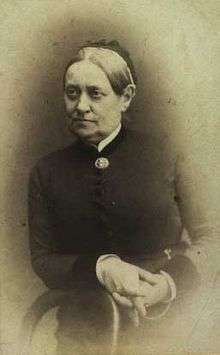Natalie Zahle

Natalie Zahle (1827–1913), was a Danish reform pedagogue and pioneer on women's education.
Her parents were the Roskilde vicar Ernst Sophus Wilhelm Zahle (1797-1837) and Vilhelmine Catharina Louise Böttger (1802-37). After the death of her parents in 1837, she lived first with her mothers parents and then as the foster child of professor and zoologist D.F. Eschricht. She was educated at the girl school Døtreskolen af 1795 in Copenhagen, and supported herself as a governess. In 1849, she became a student at the first educational institution of higher learning open to women in Denmark: the newly founded women's teacher seminar Højere Dannelsesanstalt for Damer of Annestine Beyer, the first school in Denmark to offer women a professional academic education. After having graduated from that school in 1851, she opened her first girl school.
In 1852, she was recommended to the post of manager of the small school, the Frk. Foersoms Skole, by Balthasar Münter, who was a member of the school direction of Copenhagen. He had read a thesis of hers from her period as a student regarding an educational reform for women, in which she combined the then popular view that women were meant for the home with the progressive idea that women could also be of use to the development of society as professionals. In 1852, therefore, she founded the N. Zahle's School. Her school became a famous pioneer educational institution. Known as a well-organized person, she expanded the school from 25 students in 1852 to 200 in 1862, and was known for her good judgement in her selection of teachers. A great number of famous individuals was teachers or students in her school. Employing both formally uneducated female teachers as well as educated male teachers, she combined the idea of the mother as the most important teacher and the school as a home, with the modern ideas of academically merited teachers and the school as an institution of disciplined education, and was regarded to have formed a good balance between these two contradictory leading contemporary ideas, which was regarded a great success. She also combined the traditional view that females should foremost be educated to be accomplished ornaments by education of the arts, with the progressive idea that they, as well as males, should be educated to be active, hardworking, creative and strong willed professionals, by educating them to be both.
Her way of creating a balanced combination through traditional and progressive values was called her double strategy. This was also the case with her position in other women's issues, and she refused to choose between difference feminism and equality feminism and insisted on both in parallel. Many of the first generation of women's pioneers within various fields and women's rights activists, such as Augusta Fenger, Anna Hude, Ida Falbe-Hansen, Lis Jacobsen, Ingrid Jespersen, Erna Juel-Hansen, Theodora Lang, Ingeborg Simesen and Henriette Skram, were all at one time her students. Zahle has been regarded as a great pioneer within the women's movement, though she did, in fact, never herself engage in any women's rights activism in public outside of her educational works. Until around 1900, the Danish government did not involve itself much in the education of females, and Natalie Zahle was a great innovator in reforming the education of women in Denmark during the 19th-century. In her school, females was offered primary education as children, and then move on to secondary education as a preparation for university studies (which became available in 1875), take free courses, or be educated as teachers. She started a school for female teachers in 1851; a children's primary school in 1852; free courses in 1861; physical education in 1864; a musical school in 1869; gymnasium (school) (necessary after the universities had been opened to women in Denmark in 1875) in 1877; issued professional degrees (as the first girl school in Denmark) from 1885; health care in 1880; house hold school in 1882; governmental seminar in 1894.
Politically, she was a national liberal, a patriot and a royalist, and a strict Lutheran, but she has foremost been described as a pragmatist. She never married, but lived with some of her adult female teachers and some of her students as foster children.